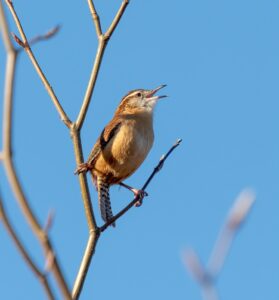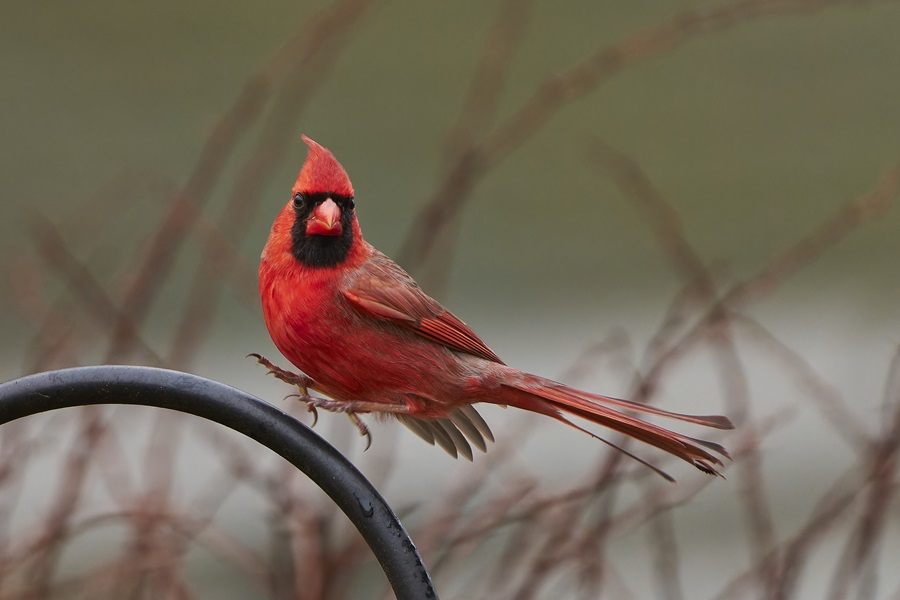Charles Townsend was an acclaimed ornithologist who lived on the North Shore of Boston. Studying the birds around him, he quickly rose to prominence as an expert on the bird life of coastal Massachusetts. His The Birds of Essex County, published in 1905, was the definitive text on the region’s birdlife.
But what was definitive that year was no longer true in 1908.
It might be hard to imagine now, but before that year, Carolina wrens were not common in Massachusetts. As Townsend wrote in the scientific journal The Auk, the brown bird with a gleaming white eyebrow was only an “accidental visitor in New England north of Rhode Island and Connecticut, and a rare summer visitor in these two southern states” of the region.

Then, in 1908, Carolina wrens invaded Massachusetts. Birds that were once unheard of in the state appeared everywhere — a singing bird in Jamaica Plain, a lone bird in Ipswich, two pairs in Brookline — and some even settled down and began nesting. Townsend estimated that, in 1908, twice as many Carolina wrens appeared in the state as had in all previous years combined.
To explain this sudden change, Townsend cited the mild winter the year before, which he supposed allowed these southern birds to spread north. But, he cautioned, this invasion likely was not part of a wider trend.
“It is probable,” Townsend wrote, “that in past times before records were kept, the same or similar favorable circumstances for extension have occurred, yet the extension has not been permanent.” Therefore, he argued, “It can hardly be expected that the Carolina Wren will make the extension of its range permanent.”
But the expansion was more than permanent. Carolina wrens were just getting started.
The wrens continued to expand their range, pushing farther north and proliferating where they arrived. Today, according to data from eBird, the Carolina wren is among the 20 most frequently seen bird species on the Cape. For much of the year, their loud, flutey teakettle-teakettle-teakettle song rings out from within bushes and thickets, and aggressive pairs chase each other around the understory, long tails cocked and curved bills chattering.
What had changed, of course, was the climate. Severe winters historically kept these birds from spreading north, but thanks to climate change, cold winters have become much rarer. This trend, combined with a broader pattern of reforestation on the East Coast, has allowed Carolina wrens to spread through the region and become the familiar, charismatic Cape Cod resident that they are today.
Townsend could never have known that climate change was behind this sudden invasion. The idea that humans could influence the planet’s climate was unheard of until the middle of the 20th century. By then, climate change had already altered Cape Cod’s birdlife, and Carolina wrens were just one example.
Take red-bellied woodpeckers. Before the 1970s, they were nearly absent from Massachusetts, but they started appearing more and more often throughout that decade. Then, in the 1980s, they had their own invasion. Christmas Bird Count data reveal that, between 1983 and 1997, the population of red-bellied woodpeckers in the state increased 20-fold. Today, they are nearly as abundant as Carolina wrens.
While reforestation has played a role in this species’ expansion, climate change sealed the deal. These woodpeckers, according to the Cornell Lab of Ornithology’s Birds of the World, are among the most climate-sensitive species in the northeastern U.S., and they cannot survive in areas with severe cold periods — but those are much rarer now than they once were.

The same is true for so many birds we now think of as ours. The blue-gray gnatcatcher experienced a massive all-in-one-year invasion in 1947. The tufted titmouse first appeared in Massachusetts in the 1960s. Black vultures, while still uncommon in New England, first bred in the region in 1998 and now breed as far north as Burlington, Vt. All of these expansions have likely been aided in part by the more hospitable winters brought on by climate change.
The most dramatic example of a new bird we’ve adopted is the northern cardinal. It feels impossible to imagine a New England winter that doesn’t feature these bright red birds perched on feeders or nestled in the snowy boughs of a cedar hedge. But the fact is they’re here only because of climate change. They first bred in Massachusetts in the 1950s, and within 20 years they were found in every corner of the state, aided by a pattern of decreasing snowfall that made searching for food easier in the winter.
These birds are not “bad” for colonizing new spaces that were previously uninhabitable for them, and they don’t seem to be invasive — no studies suggest these birds are having any negative effect on the region’s more traditional birdlife. What they are, however, is an indicator of the ways that climate change is affecting everything around us, sometimes so subversively that we can’t imagine things ever having been any different.
There are sure to be more new birds here as the weather becomes warmer. Boat-tailed grackles, a southern coastal blackbird, have been slowly spreading along the shores of southern New England. They appeared in Connecticut in 1989 and now breed at a handful of sites along the state’s coast. It seems like only a matter of time before the first Massachusetts colony springs up somewhere around New Bedford or Fall River. These birds will almost certainly reach us, and, who knows, perhaps one day become as emblematic of Cape Cod’s marshes as cardinals are of our gardens.
